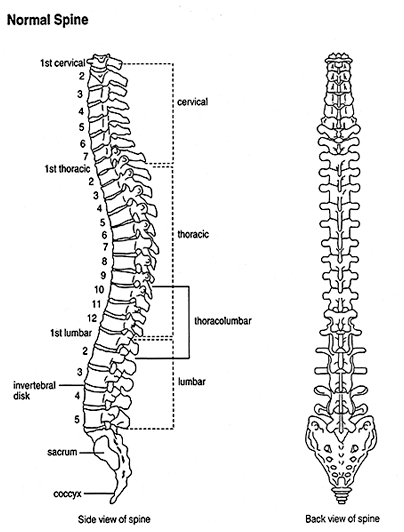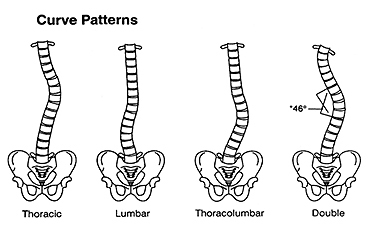Overview of Scoliosis
Scoliosis is a musculoskeletal disorder in which there is a sideways (lateral) curvature of the spine. In determining the correct diagnosis and treatment, doctors consider the location, shape, and pattern of the curve. Below are pictures of a normal spine (left) and of common scoliosis curves (right).


Are There Multiple Types of Scoliosis?
There are many forms of scoliosis. People of all ages can have scoliosis, but the focus of treatment is on children and adolescents. Of every 1,000 children, 3 to 5 develop spinal curves that are considered large enough to need treatment.
While scoliosis can be caused by a number of factors, including birth defects and neuromuscular diseases, in most cases the cause of scoliosis is unknown; this is called idiopathic scoliosis. Types of idiopathic scoliosis include:
Adolescent Idiopathic Scoliosis (AIS)
- Most common type of scoliosis in school-aged children (80-85%)
- Occurs after the age of 10
- Predominantly affects girls
- No known cause
Juvenile Idiopathic Scoliosis
- Diagnosed between the ages of 4-10
- 10-15% of all idiopathic scoliosis cases in children
- In younger children, boys are affected slightly more than girls and the curve is often left-sided
- In older children, more girls are affected and curves tend to be right-sided
Infantile Idiopathic Scoliosis, or Early Onset Idiopathic Scoliosis
- Usually diagnosed in children between birth and 3 years old
- 1% of total idiopathic scoliosis cases
- More common in Europe than the United States
- Occurs relatively equally between boys and girls
Neuromuscular Scoliosis
- Can occur at any age
- Secondary to another diagnosis such as cerebral palsy, where significant muscular weakness or spasticity is present.
- Curvature of the spine takes place over time due to muscular imbalance and lack of trunk stability
- May require a more comfortable, less rigid type of brace such as a body jacket
Congenital Scoliosis
- With patient at birth
- Congenitally anomalous vertebral development - meaning a true defect in the vertebra from birth

